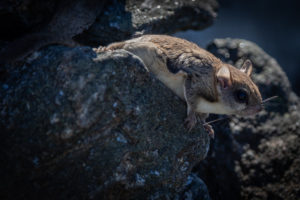You thought that this squirrel has wings, but that is not so. Though called as flying squirrels they do not have wings!
Contrary to their common name, these small tree squirrels actually glide instead of fly. They stretch out their legs, spreading the fold of skin between the front and hind legs, to form a kind of parachute that lets them glide from branch to branch.
Flying squirrels are mostly nocturnal, and can be distinguished from regular squirrels by their large, orbital eyes.

They are also known to be the most carnivorous of the group, feeding primarily on nuts and seeds, but also on insects and bird eggs.
These squirrels feed on nuts, acorns seeds, berries, some insects and bird eggs. In preparation for the colder months, some of the food is stored in the nest chamber, while the rest is hoarded in tree crotches.
Flying squirrels become pests when they take up residence in an attic where they can cause a noticeable odor and damage with their urine. The species is of very minor medical concern.
Although flying squirrels can glide for long distances, 100 feet or more depending on the starting height, Eastern Gray Squirrels can also jump a fair distance.
Some experts claim that if a flyer is 80 feet up in the air, it can glide for hundreds of feet. A flying squirrel can adjust their flight pattern via their tail and wrist bone. When preparing to land, they slow their decent with a parachute style curvature.
The life expectancy for a flying squirrel is six years and can extend to fifteen years if they are held in captivity.
Although hard to notice in the wild, and sometimes in your house, flying squirrels can quickly become hard to solve a problem once they decide to invade your home. As a matter of fact, because of their troublesome nature and the extreme frustration, they cause homeowners who end up with flying squirrels in their attic or walls.
A dozen squirrels are “partying” in a Virginia Beach woman’s attic
By Mary Reid Barrow – Correspondent
Jan 29, 2018
A slew of homeless flying squirrels – all healthy – are spending the winter with wildlife rehabilitator Connie Heibert in Virginia Beach.
They are refugees from Diana Bailey’s attic in Lake Lawson near Northampton Boulevard in Virginia Beach.
The nocturnal critters began partying their nights away in December. And Bailey sent me this report a couple weeks ago: “Right now they are holding hockey matches back and forth across my bedroom ceiling about midnight most evenings.”
Squirrel responsible for damaging Christmas lights in New Jersey town
By Travis Fedschun | Fox News
A New Jersey town’s search for the vandal who damaged a popular Christmas lights display came to an end Saturday when officials discovered the Grinch was actually a medium-sized rodent.
Officials in Sea Girt, 65 miles south of New York City, spent the past week scrambling to replace the display’s severed wires in time for the borough’s annual tree lighting on Friday, WNBC-TV reported.
The morning after the ceremony, the Sea Girt Police Department said it caught the vandal in the act, posting photos on social media of a squirrel climbing on the display and trying to take a bite out of the wires before running away.
“The Sea Girt Police Department is proud to report that the case of our broken holiday lights has been solved,” the department said in a press release. “We are happy that no human acted as a grinch in this incident. The squirrel was ‘charged’ with criminal mischief and released on bail.”
The discovery of the damaged wires originally had some residents thinking a vandal was trying to sabotage the holiday spirit.
Trapping the flying squirrels to fix the problem, is not the answer, killing and trapping sugar gliders and flying squirrels is a very difficult task for many trappers, and their methods can be harmful to the flying squirrel and the results will usually be temporary and ineffective.
C Tech Corporation can offer a solution to stop damage the damage caused by these pesky squirrels. Rodrepel™ is a non-toxic, non-hazardous, non-carcinogenic and environmentally safe, anti-rodent additive.
The masterbatch of Rodrepel™ can be incorporated into the polymeric applications like wires and cables, gas pipelines and other polymeric applications to protect them from the rodent attacks. The tree guards made of polymers can be incorporated with our masterbatch to prevent the damage caused by the flying squirrels to the trees and fruits.
The interiors and exterior of houses, schools, hospitals, warehouses, etc. can be painted by using our liquid concentrate with the paints. The liquid concentrate can be mixed with the paints in a pre-determined ratio. The liquid concentrate is compatible with all types of paints.
The product available in the form of the lacquer can be used as a topical application. It can be applied on the already installed applications like the wires and cables, pipes, tree guards etc. The lacquer can be applied on the wooden furniture and other structures can be protected using the lacquer. The lacquer is compatible with most of the surfaces like wood, metal, concrete, polymer, ceramic, etc.
RodrepelTM is cost effective and has a long shelf life. The product can effectively control the proliferation of these undesired pests! RodrepelTM is RoHS, RoHS2 ISO, APVMA, NEA and REACH compliant and FIFRA exempted.
For inquiry of our products contact us below:
technical.marketing@ctechcorporation.com
Also visit our websites:
http://www.ctechcorporation.com/
http://www.rodrepel.com/
http://www.termirepel.com/
http://www.combirepel.com/
Follow our Facebook pages at:
1] https://www.facebook.com/Combirepel-411710912249274/
2] https://www.facebook.com/Termirepel-104225413091251/
3] https://www.facebook.com/Rodrepel-120734974768048/
Follow us on our Twitter pages at:
1] https://twitter.com/rodrepel
2] https://twitter.com/termirepel
3] https://twitter.com/combirepel
